Japan Socialist Party
Japan Socialist Party (JSP), also known as the Social Democratic Party of Japan (日本社会党 (にっぽんしゃかいとう、にほんしゃかいとう, Nippon shakai-tō, Nihon shakai-tō)), was a left-wing political party in Japan that existed from 1945 to 1996.
Japan Socialist Party 日本社会党 Nippon shakai-tō or Nihon shakai-tō | |
|---|---|
 | |
| Founded | 2 November 1945[1][2] |
| Dissolved | 19 January 1996[1][2] |
| Succeeded by | Social Democratic Party[1][2] |
| Headquarters | Social & Cultural Center 1-8-1 Nagata-cho, Chiyoda-ku, Tokyo |
| Newspaper | Shakai Shimpō[3] |
| Ideology | Socialism[1] Social democracy[2] Factions: Marxism (left-wing)[1] Reformism (right-wing)[1] |
| Political position | Left-wing[4] |
| International affiliation | Socialist International[5] |
| Colors | Blue |
The party was founded by members of several former proletarian parties that existed before World War II, including the Social Mass Party, the Labour-Farmer Party and the Japan Labour-Farmer Party. JSP was briefly in power from 1947 to 1948. From 1951 to 1955, the JSP was divided into the Leftist Socialist Party (左派社会党) and the Rightist Socialist Party (右派社会党). In the same year, the two major conservative parties in Japan merged to form the Liberal Democratic Party (LDP), which established the "1955 System" (55年体制). Under the 1955 System, the LDP was able to continuously hold power, while the JSP was the largest opposition party, but was incapable of forming a government. On the other hand, the JSP managed to hold about one third of the seats in the National Diet during this period, preventing the LDP from amending the Constitution of Japan.[1][2][6]
In the late 1980s and early 1990s, the JSP under the leadership of Takako Doi earned a record-high number of seats. However, shocked by the establishment of new conservative parties, the party's seats in the National Diet decreased significantly in the mid-1990s. Finally, the JSP dissolved in 1996. Its successor is the Social Democratic Party, a minor party only holding four representatives in the National Diet as of 2020. There have been two JSP Prime Ministers of Japan, Tetsu Katayama and Tomiichi Murayama.
History
1940s–1970s
.jpg.webp)
Socialist and social-democratic parties have been active in Japan under various names since the early 20th century, often suffering harsh government repression as well as ideological dissensions and splits. The party was originally known as the Social Democratic Party of Japan (SDPJ) in English and was formed in 1945 following the fall of the militarist regime that had led Japan into World War II. At the time, there was serious conflict inside the party between factions of the right and the left and the party's official name in English became the Japanese Socialist Party (JSP) as the left-wing had advocated. The right had wanted to use the older SDPJ.
The party became the largest political party in the first general election under the Constitution of Japan in 1947 (143 of 466 seats) and a government was formed by Tetsu Katayama, forming a coalition with the Democratic Party and the Citizens' Cooperation Party. Katayama's coalition fell in February of 1948, in large part due to inexperience and subsequent poor performance in leading government.[7] Hitoshi Ashida succeeded Katayama as prime minister of a new coalition with the Democrats. In October of 1948, just seven months after taking office, Ashida resigned due to his alleged involvement in the Showa Kendo corruption scandal. In 1958, however, he was acquitted of all charges.[8] The confusion and disarray caused by the corruption scandal were part of what allowed Shigeru Yoshida and the Liberal Party to return to government.
In the period following the end of World War II, the Socialists played a key role in the drafting of the new Japanese constitution, adding progressive articles related to issues such as health, welfare and working conditions.[9] Unfortunately for the JSP and the broader Japanese left in the immediate postwar era, their time in power coincided with a change in US policy towards Japan commonly known as the Reverse Course.[10] Beginning around 1947, and intensifying with the victory of the communists over the nationalists in the Chinese Civil War in 1949, the US occupation government headed by Douglas MacArthur felt the need to revise its previously conciliatory stance towards the kinds of policies pursued by Japanese leftists, from the breakup of the country’s business conglomerates, to land reform, to the ousting of nationalist figures in government.[11] Apart from reversing early steps taken towards implementing these policies, the US occupation government oversaw and assisted in the purging of almost 30,000 workers deemed to be "red" between 1948 and 1950, frustrating leftist attempts to hold on to state power.[12]
The JSP was split in 1950–1951 into the Rightist Socialist Party, consisting of socialists who leaned more to the political centre; and the Leftist Socialist Party, formed by hardline left-wingers and socialists.[13] The faction farthest to the left formed a small independent party, the Workers and Farmers Party, espousing Maoism from 1948 to 1957. The two socialist parties were merged in 1955 and joined the Socialist International that year.[14]
The new opposition party had its own factions, although organised according to left-right ideological beliefs rather than what it called the feudal personalism of the conservative parties. In the 1958 Japanese general election, the party gained 32.9 percent of the popular vote and 166 out of 467 seats. This was enough result to block the attempt of constitutional amendment by the Kishi Nobusuke-led government. However, the party was again split in 1960 because of internal disagreement over how to conduct the ongoing Anpo protests against revision of the US-Japan Security Treaty (known as Anpo in Japanese), and whether or not to cooperate with the Communist Party of Japan in doing so. On January 24, 1960, the right-most wing of the party led by Suehiro Nishio (a part of the old Right Socialist Party of Japan), broke away to form the Democratic Socialist Party, leaving the JSP slightly weakened.[15] A further blow came in the fall of 1960 when the energetic JSP party chairmain Inejiro Asanuma was assassinated by a right-wing youth during a televised election debate.[16] After that, the party's percentage of the popular vote and number of seats gradually declined.[17] However, the party performed well on a local level and by the 1970s many areas were run by SDPJ mayors and governors (including those who were endorsed by the SDPJ), who introduced new social programmes.[18][19][20][21][22][23][24][25][26]
In 1977, some members, led by Saburō Eda (江田三郎) and Hideo Den (田英夫) respectively, left the JSP, and a minor party called Socialist Democratic Federation (社会民主連合) were formed by them in 1978.[27][28]
1980s
In the double 1986 Japanese general election of July for both National Diet houses, incduging the 1986 Japanese House of Councillors election, the party suffered a rout by the Liberal Democratic Party (LDP) under Yasuhiro Nakasone and its seats in the lower house fell from 112 to an all-time low of eighty-five and its share of the vote from 19.5 percent to 17.2 percent. Nonetheless, its popular chairwoman Takako Doi led it to an impressive showing in the 1990 Japanese general election, with 136 seats and 24.4 percent of the vote. Some electoral districts had more than one successful socialist candidate. Doi's decision to put up more than one candidate for each of the 130 districts represented a controversial break with the past because unlike their LDP counterparts many party candidates did not want to run against each other. However, the great majority of the 149 socialist candidates who ran were successful, including seven of eight women.
Doi, a university professor of constitutional law before entering politics, had a tough, straight-talking manner that appealed to voters tired of the evasiveness of other politicians. Many women found her a refreshing alternative to submissive female stereotypes and in the late 1980s the public at large in opinion polls voted her their favorite politician (the runner-up in these surveys was equally tough-talking conservative LDP member Shintarō Ishihara). However, Doi's popularity was of limited aid to the party. The powerful Shakaishugi Kyokai (Japan Socialist Association) which was supported by a hardcore contingent of the party's 76,000-strong membership remained committed to doctrinaire Marxism, impeding Doi's efforts to promote what she called perestroika and a more moderate program with greater voter appeal. In 1983, Doi's predecessor as chairman Masashi Ishibashi began the delicate process of moving the party away from its strong opposition to the Self-Defense Forces. While maintaining that these forces were unconstitutional in light of Article 9, he claimed that because they had been established through legal procedures, they had a legitimate status (this phrasing was changed a year later to say that the Self-Defense Forces exist legally). Ishibashi also broke past precedent by visiting Washington to talk with United States political leaders.
By the end of the decade, the party had accepted the Self-Defense Forces and the 1960 Japan–United States Treaty of Mutual Cooperation and Security. It advocated strict limitations on military spending (no more than 1 percent of GNP annually), a suspension of joint military exercises with United States forces and a reaffirmation of the three non-nuclear principles (no production, possession, or introduction of nuclear weapons into Japanese territory). Doi expressed support for balanced ties with the Democratic People's Republic of Korea (North Korea) and the Republic of Korea (South Korea). In the past, the party had favored the Kim Il-sung regime in Pyongyang and in the early 1990s it still refused to recognize the normalization of relations between Tokyo and Seoul with Treaty on Basic Relations between Japan and the Republic of Korea (1965). In domestic policy, the party demanded the continued protection of agriculture and small business in the face of foreign pressure, abolition of the consumption tax and an end to the construction and use of nuclear power reactors. As a symbolic gesture to reflect its new moderation, the party dropped its commitment to socialist revolution at its April 1990 convention and described its goal as social democracy,[29] the creation of a society in which "all people fairly enjoy the fruits of technological advancement and modern civilization and receive the benefits of social welfare". Delegates also elected Doi to a third term as party chairwoman.
Because of the party's self-definition as a class-based party and its symbiotic relationship with the General Council of Trade Unions of Japan (Sōhyō), the public-sector workers' confederation, few efforts were made to attract non-union constituencies. Although some Sōhyō unions supported the Japanese Communist Party, the party remained the representative of Sohyo's political interests until the merger with private-sector unions and the Japanese Trade Union Confederation (Rengō) in 1989. Because of declining union financial support during the 1980s, some party Diet members turned to dubious fund-raising methods. One was involved in the Recruit affair. Like other parties, it sold large blocks of fund-raising party tickets and the LDP even gave individual party Diet members funds from time to time to persuade them to cooperate in passing difficult legislation.
1990s
The party acquired seventy seats (down from 137) in the 1993 Japanese general election while the LDP lost its majority in the lower house for the first time since the 1983 Japanese general election and was out of government for the first time in 38 years. The anti-LDP coalition government of Morihiro Hosokawa was formed by reformists who had triggered the 1993 election by leaving the LDP (Japan Renewal Party and New Party Sakigake), a liberal party formed only a year before (Japan New Party), the traditional centre-left opposition (Kōmeitō, Democratic Socialist Party and Socialist Democratic Federation) and the Democratic Reform Party, the political arm of the Rengō trade union federation, together with the JSP. In 1994, the JSP and the New Sakigake Party decided to leave the non-LDP coalition. The minority Hata cabinet lasted only a few weeks.
The JSP then formed a grand coalition (dai-renritsu) government with the LDP and the New Party Sakigake under Prime Minister Tomiichi Murayama, leader of the party from 1993 to 1996. Most of the other parties from the anti-LDP coalition forced back into opposition, united to form the New Frontier Party (NFP) and overtaking the JSP as second largest political party in Japan. The JSP lost in the 1995 Japanese House of Councillors election.
In January 1996, the New Socialist Party of Japan split off, Murayama resigned as Prime Minister and the JSP changed its name from the JSP to the Social Democratic Party (SDP) as an interim party for forming a new party.
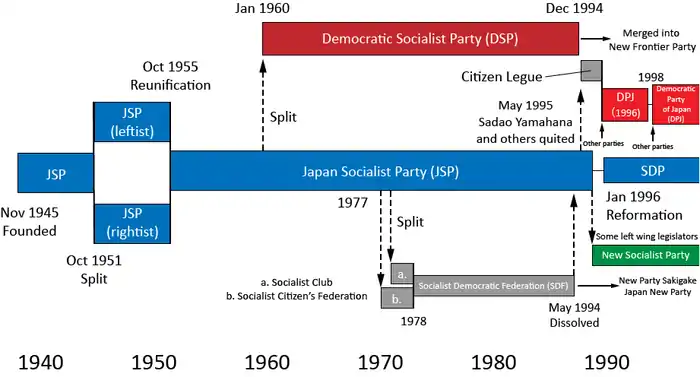
Ideology
The JSP supported a neutralist foreign policy and opposed amending the Constitution of Japan, especially the Article 9 of the Constitution of Japan.[1][2]
The so-called "lefists" in the JSP were Marxists in favour of scientific socialism. By contrast, the so-called "rightists" were in favour of social democracy and aimed at establishing a welfare state.[30]
Leaders
| No. | Photo | Name | Term of office | ||
|---|---|---|---|---|---|
| Took office | Left office | ||||
| Chair of the Social Democratic Party of Japan | |||||
| 1 |  | Tetsu Katayama | 28 September 1946 | 16 January 1950 | |
| Chair of the Social Democratic Party of Japan (Rightist) | |||||
| — |  | Jōtarō Kawakami | 19 January 1951 | 12 October 1955 | |
| Chair of the Japanese Socialist Party (Leftist) | |||||
| — |  | Suzuki Mosaburō | 18 January 1951 | 12 October 1955 | |
| Chair of the Social Democratic Party of Japan (Unified) | |||||
| 2 |  | Suzuki Mosaburō | 12 October 1955 | 23 March 1960 | |
| 3 | 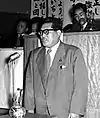 | Inejiro Asanuma | 23 March 1960 | 12 October 1960 (assassinated) | |
| — | 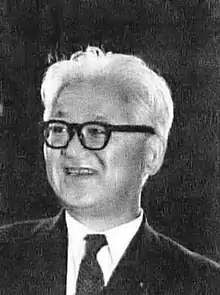 | Saburō Eda (acting) | 12 October 1960 | 6 March 1961 | |
| 4 |  | Jōtarō Kawakami | 6 March 1961 | 6 May 1965 | |
| 5 |  | Kouzou Sasaki | 6 May 1965 | 19 August 1965 | |
| 6 |  | Seiichi Katsumata | 19 August 1965 | 4 October 1968 | |
| 7 | Tomomi Narita | 30 November 1968 | 26 September 1977 | ||
| 8 |  | Ichio Asukata | 13 December 1977 | 7 September 1983 | |
| 9 | 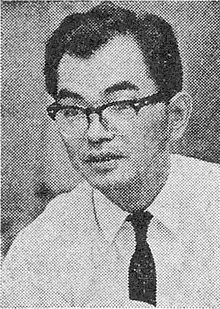 | Masashi Ishibashi | 7 September 1983 | 8 September 1986 | |
| 10 | 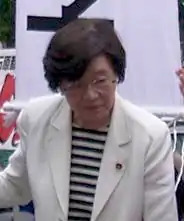 | Takako Doi | 9 September 1986 | 31 July 1991 | |
| 11 | Makoto Tanabe | 31 July 1991 | 19 January 1993 | ||
| 12 | Sadao Yamahana | 19 January 1993 | 25 September 1993 | ||
| 13 |  | Tomiichi Murayama | 25 September 1993 | 19 January 1996 | |
Election results
General election results
| Election | Leader | No. of seats won |
No. of constituency votes |
% of constituency votes |
No. of PR block votes |
% of PR block votes |
Government | |
|---|---|---|---|---|---|---|---|---|
| Japan Socialist Party era | ||||||||
| 1946 | Tetsu Katayama | 96 / 466 |
10,069,907 | 18.2 | Opposition | |||
| 1947 | Tetsu Katayama | 144 / 466 |
7,203,050 | 26.3 | Coalition | |||
| 1949 | Tetsu Katayama | 48 / 466 |
4,129,794 | 13.8 | Opposition | |||
| 1952 | Jōtarō Kawakami Mosaburō Suzuki |
116 / 466 |
8,001,745 | 22.6 | Opposition | |||
| 1953 | Jōtarō Kawakami Mosaburō Suzuki |
138 / 466 |
9,194,548 | 26.6 | Opposition | |||
| 1955 | Jōtarō Kawakami Mosaburō Suzuki |
156 / 466 |
10,812,906 | 29.2 | Opposition | |||
| 1958 | Mosaburō Suzuki | 167 / 467 |
13,155,715 | 33.1 | Opposition | |||
| 1960 | Jōtarō Kawakami | 144 / 467 |
10,839,130 | 27.4 | Opposition | |||
| 1963 | Jōtarō Kawakami | 144 / 467 |
11,906,766 | 29.0 | Opposition | |||
| 1967 | Kōzō Sasaki | 140 / 486 |
12,826,104 | 27.9 | Opposition | |||
| 1969 | Tomomi Narita | 90 / 486 |
10,074,101 | 21.4 | Opposition | |||
| 1972 | Tomomi Narita | 118 / 491 |
11,478,142 | 21.9 | Opposition | |||
| 1976 | Tomomi Narita | 123 / 511 |
11,713,009 | 20.7 | Opposition | |||
| 1979 | Ichio Asukata | 107 / 511 |
10,643,450 | 19.7 | Opposition | |||
| 1980 | Ichio Asukata | 107 / 511 |
11,400,747 | 19.3 | Opposition | |||
| 1983 | Masashi Ishibashi | 112 / 511 |
11,065,082 | 19.5 | Opposition | |||
| 1986 | Masashi Ishibashi | 85 / 512 |
10,412,584 | 17.2 | Opposition | |||
| 1990 | Takako Doi | 136 / 512 |
16,025,473 | 24.4 | Opposition | |||
| 1993 | Sadao Yamahana | 70 / 511 |
9,687,588 | 15.4 | Eight-party coalition (1993–1994) | |||
| LDP–JSP–NPS coalition (1994–1996) | ||||||||
Councillors election results
| Election | Leader | No. of seats total |
No. of seats won |
No. of National votes |
% of National vote |
No. of Prefectural votes |
% of Prefectural vote | |
|---|---|---|---|---|---|---|---|---|
| 1947 | Tetsu Katayama | 47 / 250 |
3,479,814 | 16.4% | 4,901,341 | 23.0% | ||
| 1950 | Tetsu Katayama | 61 / 250 |
36 / 125 |
4,854,629 | 17.3% | 7,316,808 | 25.2% | |
| 1953 | Mosaburō Suzuki | 66 / 250 |
28 / 125 |
5,559,875 | 20.7% | 6,870,640 | 24.5% | |
| 1956 | Mosaburō Suzuki | 80 / 250 |
49 / 127 |
8,549,940 | 29.9% | 11,156,060 | 37.6% | |
| 1959 | Mosaburō Suzuki | 85 / 250 |
38 / 127 |
7,794,754 | 26.5% | 10,265,394 | 34.1% | |
| 1962 | Jōtarō Kawakami | 66 / 250 |
37 / 127 |
8,666,910 | 24.2% | 11,917,675 | 32.8% | |
| 1965 | Kōzō Sasaki | 73 / 251 |
36 / 127 |
8,729,655 | 23.4% | 12,346,650 | 32.8% | |
| 1968 | Tomomi Narita | 65 / 250 |
28 / 126 |
8,542,199 | 19.8% | 12,617,680 | 29.2% | |
| 1971 | Tomomi Narita | 66 / 249 |
39 / 125 |
8,494,264 | 21.3% | 12,597,644 | 31.2% | |
| 1974 | Tomomi Narita | 62 / 250 |
28 / 130 |
7,990,457 | 15.2% | 13,907,865 | 26.0% | |
| 1977 | Ichio Asukata | 56 / 249 |
27 / 126 |
8,805,617 | 17.3% | 13,403,216 | ||
| 1980 | Ichio Asukata | 47 / 250 |
22 / 126 |
7,341,828 | 13.1% | 12,715,880 | ||
| 1983 | Ichio Asukata | 44 / 252 |
22 / 126 |
7,590,331 | 16.3% | 11,217,515 | ||
| 1986 | Takako Doi | 41 / 252 |
20 / 126 |
9,869,088 | 12,464,579 | |||
| 1989 | Takako Doi | 68 / 252 |
45 / 126 |
19,688,252 | 35.1% | 15,009,451 | 26.4% | |
| 1992 | Takako Doi | 71 / 252 |
22 / 126 |
7,981,726 | 17.8% | 7,147,140 | 15.8% | |
| 1995 | Tomiichi Murayama | 37 / 252 |
16 / 126 |
6,882,919 | 16.9% | 4,926,003 | 11.9% | |
References
- ブリタニカ国際大百科事典 小項目事典の解説 [The Encyclopædia Britannica: Micropædia 's explanation]. kotobank.jp (in Japanese). The Asahi Shimbun Company. Retrieved November 22, 2020.
- Taguchi, Fukuji. 日本大百科全書(ニッポニカ)の解説 [The Nihon Dai Hyakka Zensho: Nipponica 's explanation]. kotobank.jp (in Japanese). The Asahi Shimbun Company. Retrieved November 19, 2020.
- 社会新報とは § ブリタニカ国際大百科事典 小項目事典の解説 [What is Shakai Shimpō? § The Encyclopædia Britannica: Micropædia 's explanation]. kotobank.jp (in Japanese). The Asahi Shimbun Company. Retrieved November 22, 2020.
- "Social Democratic Party of Japan | political party, Japan". Encyclopædia Britannica Online. Encyclopædia Britannica, Inc. Retrieved November 22, 2020.
- Docherty, James C.; Lamb, Peter (2006). Historical Dictionary of Socialism. Historical Dictionaries of Religions, Philosophies, and Movements Series (2nd ed.). The Scarecrow Press. p. 186. ISBN 978-0-8108-5560-1. Retrieved November 22, 2020.
- Ken Saito (2019). 圖說日本大事記:1945-2017,改變與形塑現代日本的百大事件. 麥浩斯. p. 50. ISBN 978-986-408-463-0.
- Lee, Yong Wook. "The Origin of One Party Domination: America's Reverse Course and the Emergence of the Liberal Democratic Party in Japan". The Journal of East Asian Affairs. Vol. 18 (No.2): 388. Retrieved 26 January 2021.
- Hoover, William D. (2011). Historical Dictionary of Postwar Japan. Plymouth, UK: Scarecrow Press. p. 33. ISBN 978 0 8108 5460 4.
- Takemae, Eiji (January 2003). Allied Occupation of Japan. ISBN 9780826415219. Archived from the original on 3 May 2018. Retrieved 12 July 2015.
- "Occupation and Reconstruction of Japan, 1945–52". Retrieved 26 January 2021.
By late 1947 and early 1948, the emergence of an economic crisis in Japan alongside concerns about the spread of communism sparked a reconsideration of occupation policies. This period is sometimes called the “reverse course.
- Schonberger, Howard B. (1989). Aftermath of War: Americans and the Remaking of Japan, 1945-1952. Kent, Ohio: The Kent State University Press. p. 64-72. ISBN 0 87338 382 6.
- Dower, John W.; Hirata, Tetsuo. "Japan's Red Purge: Lessons from a Saga of Suppression of Free Speech and Thought". The Asia-Pacific Journal. 5 (7): 3. Retrieved 26 January 2021.
- Socialist parties in postwar Japan, by Allan B. Cole, George O. Totten [and] Cecil H. Uyehara, New Haven : Yale University Press, 1966.
- James C. Docherty; Peter Lamb (2 October 2006). Historical Dictionary of Socialism. Scarecrow Press. pp. 186–. ISBN 978-0-8108-6477-1. Retrieved 29 January 2013.
- Kapur, Nick (2018). Japan at the Crossroads: Conflict and Compromise after Anpo. Cambridge, MA: Harvard University Press. pp. 109–113. ISBN 978-0-6749-8442-4.
- Kapur, Nick (2018). Japan at the Crossroads: Conflict and Compromise after Anpo. Cambridge, MA: Harvard University Press. p. 127. ISBN 978-0-6749-8442-4.
- Kapur, Nick (2018). Japan at the Crossroads: Conflict and Compromise after Anpo. Cambridge, MA: Harvard University Press. pp. 125–26. ISBN 978-0-6749-8442-4.
- Contemporary Japan by Duncan McCargo
- "Towards Political Inclusiveness: The Changing Role of Local Government in Japan" (PDF). Archived (PDF) from the original on 2012-12-02. Retrieved 2012-04-20.
- Hein, Carola; Pelletier, Philippe (2006-09-27). Cities, Autonomy, and Decentralization in Japan. ISBN 9781134341504. Archived from the original on 27 November 2016. Retrieved 12 July 2015.
- Stockwin, J. A. A. (2003-12-16). Dictionary of the Modern Politics of Japan. Taylor & Francis. p. 239. ISBN 9780203402177. Retrieved 12 July 2015.
Japan Tokyo governor minobe free health care.
- Muramatsu, Michio; Iqbal, Farrukh; Kume, Ikuo (2001). Local Government Development in Post-war Japan. ISBN 9780199248285. Archived from the original on 27 November 2016. Retrieved 12 July 2015.
- Gaunder, Alisa (2011-02-25). Routledge Handbook of Japanese Politics. ISBN 9781136818387. Archived from the original on 27 November 2016. Retrieved 12 July 2015.
- "FEATURE: Seeds planted by 'progressive' governments still sprouting in Japan". Retrieved 12 July 2015.
- "Controlled Decentralization: Local Governments and the Ministry of Home Affairs in Japan" (PDF). Archived (PDF) from the original on 2015-07-12. Retrieved 2013-08-10.
- Tsuzuki, Chushichi (2000-04-13). The Pursuit of Power in Modern Japan 1825-1995. ISBN 9780191542459. Archived from the original on 3 May 2018. Retrieved 12 July 2015.
- 社会民主連合. 朝日新聞社Kotobank. Archived from the original on 2020-02-26. Retrieved 2020-02-26.
- 江田三郎. 朝日新聞社Kotobank. Archived from the original on 2020-02-26. Retrieved 2020-02-26.
- Ian Neary (12 October 2012). War, Revolution and Japan. Taylor & Francis. pp. 141–. ISBN 978-1-873410-08-0. Retrieved 29 January 2013.
- 高山直人 (2019). 左翼大辞典. 明哲の舎. p. 7. GGKEY:9NSLG3F0CUC.